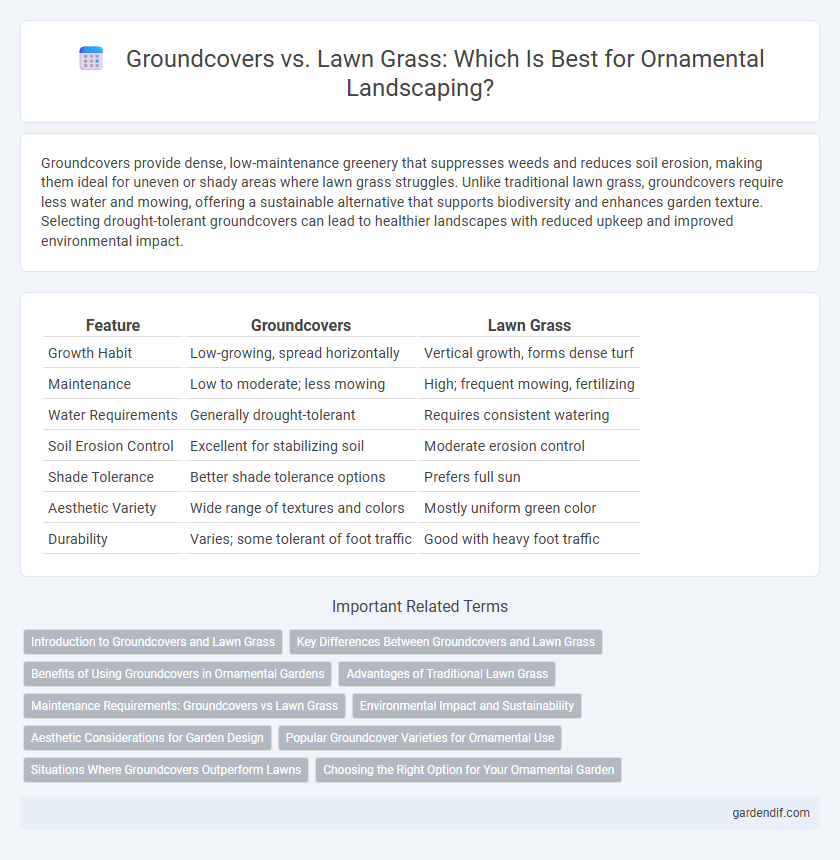
Groundcovers vs Lawn Grass Illustration
Groundcovers provide dense, low-maintenance greenery that suppresses weeds and reduces soil erosion, making them ideal for uneven or shady areas where lawn grass struggles. Unlike traditional lawn grass, groundcovers require less water and mowing, offering a sustainable alternative that supports biodiversity and enhances garden texture. Selecting drought-tolerant groundcovers can lead to healthier landscapes with reduced upkeep and improved environmental impact.
Table of Comparison
| Feature | Groundcovers | Lawn Grass |
|---|---|---|
| Growth Habit | Low-growing, spread horizontally | Vertical growth, forms dense turf |
| Maintenance | Low to moderate; less mowing | High; frequent mowing, fertilizing |
| Water Requirements | Generally drought-tolerant | Requires consistent watering |
| Soil Erosion Control | Excellent for stabilizing soil | Moderate erosion control |
| Shade Tolerance | Better shade tolerance options | Prefers full sun |
| Aesthetic Variety | Wide range of textures and colors | Mostly uniform green color |
| Durability | Varies; some tolerant of foot traffic | Good with heavy foot traffic |
Introduction to Groundcovers and Lawn Grass
Groundcovers are low-growing plants that spread rapidly to cover soil, reducing erosion and suppressing weeds, making them ideal for ornamental landscaping. Lawn grass varieties, such as Kentucky bluegrass and fescue, provide a uniform, green appearance commonly used for recreational spaces and formal gardens. Selecting between groundcovers and lawn grass depends on factors like maintenance requirements, soil conditions, and desired aesthetic effects.
Key Differences Between Groundcovers and Lawn Grass
Groundcovers provide dense, low-growing vegetation that requires less maintenance and water compared to traditional lawn grass, making them ideal for erosion control and shade tolerance. Lawn grass offers a uniform, soft surface suited for recreational activities but demands frequent mowing, watering, and fertilization. The choice between groundcovers and lawn grass depends on site conditions, desired aesthetic, and functional use within ornamental landscaping.
Benefits of Using Groundcovers in Ornamental Gardens
Groundcovers in ornamental gardens provide superior soil erosion control and moisture retention compared to traditional lawn grass, enhancing plant health and garden sustainability. Their diverse textures and colors create visually appealing, low-maintenance landscapes that reduce the need for frequent mowing and chemical treatments. Groundcovers also support biodiversity by offering habitat for beneficial insects and reducing weed growth through dense, natural coverage.
Advantages of Traditional Lawn Grass
Traditional lawn grass provides a uniform and resilient surface ideal for high-traffic areas, enhancing outdoor recreational activities and aesthetic appeal. Its deep root system improves soil structure and moisture retention, promoting healthy ecosystems and reducing erosion risks. Lawn grass also offers superior cooling effects compared to groundcovers, contributing to lower ambient temperatures in residential landscapes.
Maintenance Requirements: Groundcovers vs Lawn Grass
Groundcovers typically require less frequent mowing, watering, and fertilizing compared to lawn grass, making them a low-maintenance alternative for soil coverage. Lawn grass demands regular mowing, consistent irrigation, and seasonal fertilization to maintain an even, vibrant appearance. Selecting groundcovers can reduce overall yard maintenance time and expenses while providing effective erosion control and weed suppression.
Environmental Impact and Sustainability
Groundcovers reduce soil erosion and water runoff more effectively than traditional lawn grass, promoting biodiversity and supporting local ecosystems by providing habitats for pollinators and beneficial insects. They generally require less water, fertilizer, and mowing, significantly lowering carbon emissions and resource consumption compared to conventional turfgrass. Choosing native or drought-tolerant groundcovers enhances environmental sustainability by conserving water resources and minimizing chemical inputs in landscaping.
Aesthetic Considerations for Garden Design
Groundcovers offer diverse textures, colors, and seasonal interest, enhancing garden aesthetics with dynamic visual appeal in contrast to uniform lawn grass. Varieties like creeping thyme, sedum, and ajuga create naturalistic, low-maintenance carpets that complement garden structures and flower beds. Lawn grass provides a traditional, clean green surface but lacks the intricate patterns and floral bursts that groundcovers introduce for an enriched landscape design.
Popular Groundcover Varieties for Ornamental Use
Creeping thyme, ajuga, and sedum are popular groundcover varieties known for their ornamental appeal, low maintenance, and ability to suppress weeds. These plants provide vibrant textures and colors that enhance garden aesthetics while reducing water usage compared to traditional lawn grass. Groundcovers are often favored in landscape design for areas with poor soil or heavy foot traffic where grass struggles to thrive.
Situations Where Groundcovers Outperform Lawns
Groundcovers outperform lawn grass in shaded areas where sunlight is limited, providing dense, low-maintenance coverage that suppresses weed growth and prevents soil erosion. They are ideal for steep slopes or uneven terrain where mowing is difficult or unsafe, offering better ground stability and moisture retention. Groundcovers also thrive in drought-prone regions, reducing water usage compared to traditional lawn grasses that require frequent irrigation.
Choosing the Right Option for Your Ornamental Garden
Groundcovers like creeping thyme or moss provide low-maintenance, drought-resistant options that enhance texture and color diversity in ornamental gardens compared to traditional lawn grass. Lawn grass varieties such as Kentucky bluegrass offer a lush, uniform appearance but require regular watering, mowing, and fertilization to maintain their aesthetic appeal. Selecting the right choice depends on your garden's sunlight exposure, soil type, and maintenance preferences, ensuring a harmonious balance between functionality and ornamental beauty.
Groundcovers vs Lawn Grass Infographic

 gardendif.com
gardendif.com